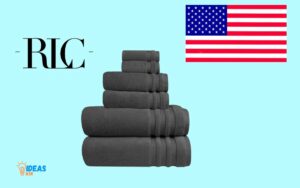Can You Wash Bath Towels With Clothes? Yes!
Yes, you can wash bath towels with clothes.
However, it is advisable to separate them to prevent potential issues such as color bleed or the rough towel textures damaging more delicate fabrics.
While it is technically possible to wash bath towels with clothes, it’s not typically recommended. Towels are generally bulkier and heavier, and their rough texture can cause wear and tear on more delicate clothing items.
Towels tend to produce a lot of lint which can stick on your clothes. There’s also the risk of color bleed from new towels. While it might save time to wash bath towels with clothes, it’s generally better to separate them.
This is due to the risk of damage to delicate clothing items, potential color bleed from towels, and different drying times. So, to extend the life of your clothes, it’s best to separate your laundry based on the fabric and color.

Key Takeaway
Understanding The Impact Of Cleanliness On Health And Hygiene
Understanding the impact of cleanliness on health and hygiene is essential. However, it is not recommended to wash bath towels with clothes due to the risk of cross-contamination. It is best to wash them separately to maintain optimal hygiene levels.
Maintaining clean towels and clothes is essential for ensuring good health and hygiene. The cleanliness of these textiles can have a significant impact on our overall well-being.
We will explore the significance of keeping towels and clothes clean, discuss the potential health risks of unclean textiles, and address the importance of proper washing techniques.
Exploring The Significance Of Maintaining Clean Towels And Clothes
- Clean towels and clothes contribute to a healthy and hygienic lifestyle.
- Using clean towels and clothes reduces the risk of skin infections and other health issues.
- Properly washed textiles provide a fresh and pleasant user experience.
- Clean towels and clothes help us feel clean and confident in our daily activities.
The Potential Health Risks Of Unclean Textiles
- Unclean towels and clothes harbor bacteria, fungi, and other pathogens.
- Dirty textiles can lead to skin irritations, rashes, and allergies.
- Unclean towels, especially when used for personal hygiene, can spread infections.
- Unwashed clothes can retain odor, making them less comfortable to wear.
Addressing The Importance Of Proper Washing Techniques
- Washing towels and clothes separately from one another helps prevent cross-contamination.
- Use an appropriate amount of detergent and follow the care instructions on the labels.
- Washing at the right temperature ensures effective removal of dirt, bacteria, and other contaminants.
- Drying towels and clothes thoroughly after washing prevents the growth of mold and mildew.
Maintaining cleanliness in towels and clothes is crucial for promoting good health and hygiene. Clean textiles not only contribute to our physical well-being but also enhance our overall comfort.
By following proper washing techniques and practicing regular cleanliness, we can ensure that our towels and clothes remain fresh, clean, and safe to use.
Understanding Bath Towels and Clothes
Materials:
Bath Towels:
- Cotton: Cotton is a popular choice for bath towels due to its absorbent nature and soft feel. Egyptian cotton and Turkish cotton are known for their long fibers, making them luxurious and highly absorbent.
- Bamboo: Towels made from bamboo fibers are eco-friendly, hypoallergenic, and have natural antimicrobial properties. They are also soft and absorbent.
- Microfiber: Microfiber towels are made from a blend of polyester and nylon. They are lightweight, quick-drying, and known for their durability. However, they might not be as soft as cotton towels.
Clothes:
- Cotton: Cotton is widely used for clothing due to its breathability, comfort, and versatility. It comes in various forms, such as combed cotton for a softer feel and pima cotton for higher quality.
- Linen: Linen is a natural fabric made from the fibers of the flax plant. It is lightweight, breathable, and has a distinctive texture. Linen clothes are comfortable in warm weather.
- Wool: Wool is a natural fiber obtained from sheep. It is known for its warmth, moisture-wicking properties, and durability. Wool clothes are suitable for colder climates.
Weave Wonders:
Bath Towels:
- Terry Cloth: The most common weave for bath towels is terry cloth, characterized by loops on both sides of the fabric. These loops increase the surface area for absorption, making the towels highly effective at drying.
- Velour: Velour towels have a velvety feel on one side, often created by cutting the loops of terry cloth. They are softer but may be less absorbent.
Clothes:
- Plain Weave: Commonly used in cotton shirts, a plain weave is simple and durable. It has an equal number of warp and weft threads, creating a balanced and breathable fabric.
- Twill Weave: Twill fabrics have a diagonal pattern, providing a unique texture. Denim is a classic example of twill weave, known for its durability and strength.
- Herringbone: This V-shaped weave is often used in suits and outerwear. It adds a touch of sophistication and visual interest to the fabric.
Weight:
Bath Towels:
- Standard Weight: Bath towels typically range from 450 to 600 grams per square meter (GSM). Standard weight towels are versatile for everyday use.
- Heavyweight: Towels with a higher GSM, such as 600 and above, are considered heavyweight. They are thicker and more luxurious but may take longer to dry.
Clothes:
- Lightweight: Summer clothes are often made with lightweight fabrics, such as cotton or linen, to provide comfort in warmer weather.
- Medium Weight: Many everyday clothes fall into this category, suitable for spring and fall. They offer a balance between warmth and breathability.
- Heavyweight: Winter clothes, like wool coats or sweaters, are designed to provide insulation and warmth. They are made from thicker materials with higher GSM.
Exploring The Differences Between Towels And Clothes
Washing bath towels with clothes may not always be a good idea. Towels have a different fabric and tend to shed lint, which can stick to clothing.
It is advisable to wash towels separately to maintain their quality and prevent lint transfer. When it comes to laundry, there are often debates about whether it’s okay to wash bath towels with clothes.
Some argue that tossing everything together saves time and energy, while others believe that separating towels from clothes is essential.
We’ll dive into the differences between towels and clothes, highlighting the varying fabric types and their care needs.
Understanding these distinctions will help shed light on why it’s important to keep towels and clothes separate during laundry sessions.
Highlighting The Varying Fabric Types And Their Care Needs:
Cotton towels
These are the most common type of bath towels, known for their absorbency and softness.
They require gentle care to maintain their quality:
- Opt for mild detergents that won’t damage the fibers.
- Avoid using bleach or fabric softeners that can leave residue and reduce absorbency.
- Wash in warm water and tumble dry on low heat to prevent excessive shrinkage.
Delicate clothes
Delicate fabrics like silk, lace, and chiffon require careful handling to avoid damage:
- Wash these items separately to prevent snags from zippers, buttons, or rougher fabrics.
- Use a delicate cycle with a gentle detergent designed specifically for delicate fabrics.
- Air drying or using a low-heat setting in the dryer can prevent shrinking or stretching.
Synthetic fabrics
Clothes made from synthetic fibers like polyester, nylon, and spandex have different care needs:
- Wash these items separately from towels to prevent lint transfer.
- Use a mild detergent and avoid bleach or fabric softeners that can damage the synthetic fibers.
- Opt for a low-heat setting when drying to prevent excessive shrinking or melting.
The Unique Requirements Of Different Textiles:
Towels
Bath towels are designed to absorb moisture, which means they accumulate dirt, skin cells, and oils. Washing them separately ensures thorough cleaning and prevents these substances from transferring to clothes.
Clothes
Garments come in various materials, each with its own specific care instructions. Separating towels from clothes allows you to address the unique requirements of each fabric type, ensuring optimal cleanliness and maintenance.
Understanding Why Separating Towels And Clothes Is Essential:
- Hygiene: Towels, especially bath towels, can harbor bacteria and germs due to their usage. Washing them separately ensures that these contaminants are not transferred to clothes, helping maintain proper hygiene.
- Lint transfer: Towels are prone to shedding lint, which can cling to clothes during washing. Separating towels from clothes prevents lint transfer, keeping your garments lint-free and in pristine condition.
- Preservation of quality: Different fabric types have specific care needs, as mentioned earlier. Separating towels from clothes allows you to address these needs individually, preventing damage, fading, or shrinkage that improper care could cause.
By understanding the differences between towels and clothes, and their varying care requirements, you can make informed decisions when it comes to laundry.
Remember to separate your towels from clothes to ensure optimal cleanliness, hygiene, and preservation of their quality.
Evaluating The Feasibility Of Washing Towels And Clothes Together
Washing towels and clothes together might seem like a convenient time-saving option, but is it really feasible?
Examining The Potential Consequences Of Mixing Textiles:
Mixing towels with clothes in the same wash load can have certain consequences.
Here are some potential issues to consider:
- Color bleeding: Certain textiles, especially new or brightly colored ones, may bleed dye during the wash. This can lead to discoloration of your towels or clothes.
- Lint transfer: Towels are notorious for shedding lint, which can easily stick to clothes. Washing them together increases the chances of lint transfer, leaving your garments covered in unwanted fuzz.
- Abrasion: Towels have a rougher texture compared to most clothes, which means they can create friction and cause damage or pilling to delicate fabrics.
- Absorption interference: Towels are designed to absorb moisture, but when mixed with clothes, they may hinder the absorbency of fabrics like sportswear or microfiber.
Debunking Common Misconceptions About Washing Towels And Clothes Together:
There are a few common misconceptions surrounding the practice of washing towels and clothes together.
Let’s debunk them now:
- Save water and energy: While it may be tempting to combine loads to minimize water and energy usage, the potential consequences can offset the benefits. Separate loads might be more efficient in the long run.
- Cleaning efficiency: Some believe that washing towels and clothes together will help to clean them better. However, combining different fabrics can actually compromise the cleanliness and longevity of both towels and clothes.
- Time-saving: Although washing towels and clothes together may save time, you may end up spending more time and effort dealing with color bleeding, lint removal, or potential damage to your garments.
- Convenience: It might seem convenient to toss everything in the same load, but sorting your laundry according to fabrics and colors will ensure better results and prevent any unnecessary mishaps.
Remember, even though washing towels and clothes together may seem like a time-saving hack, it’s important to consider the potential consequences.
To maintain the quality and longevity of both your towels and clothes, separate loads based on fabric type, color, and care instructions is generally the best practice.
The Pros And Cons Of Washing Towels And Clothes Together
Washing towels with clothes has pros and cons. It saves time and energy, but it can lead to lint transfer and decrease towel absorbency. Consider these factors before deciding.
Discussing The Advantages Of Washing Towels And Clothes Together
Washing bath towels with clothes may seem like a convenient way to save time and energy.
Let’s explore the potential benefits of combining these laundry items:
- Efficiency: Washing towels and clothes together can be a time-saving approach. Rather than running separate loads for each item, you can tackle multiple laundry tasks in one cycle, maximizing your productivity.
- Conservation of resources: By washing towels and clothes together, you can reduce water consumption and energy usage. This eco-friendly practice helps conserve resources and contributes to a more sustainable lifestyle.
- Saving detergent: Combining towels and clothes in one load can optimize the use of detergent. Instead of measuring detergent separately for each load, you can use an appropriate amount for the entire mixed load, minimizing waste.
Weighing The Potential Drawbacks Of Combining Laundry Items
While there are advantages to washing towels and clothes together, it’s essential to consider the potential drawbacks:
- Cross-contamination: Bath towels that carry dirt, bacteria, or body oils might transfer these impurities to your clothes during washing. This can diminish the cleanliness and freshness of your garments.
- Uneven drying: Towels tend to absorb more water than regular clothes. This can result in longer drying times for your entire load and potentially leave clothes damp or wrinkled.
- Lint transfer: Towels, especially new or high-quality ones, tend to shed lint. When washed with clothes, they can transfer lint onto your garments, compromising their appearance.
Exploring Alternative Solutions For Efficient Washing
If the drawbacks of washing towels and clothes together outweigh the benefits, consider these alternatives for efficient laundry:
- Separate loads: Washing towels and clothes separately ensures optimal cleanliness and minimizes the risk of cross-contamination. This approach also allows you to adjust settings specifically for each load’s requirements.
- Color sorting: Dividing your laundry by color can prevent color bleeding accidents, maintaining the vibrancy of your clothes. This practice ensures that dark, light, and colored items receive the appropriate treatment.
- Using laundry bags: Placing delicate garments, such as lingerie or sweaters, in mesh laundry bags can protect them from rougher fabrics like towels. This additional layer of protection prevents snags or damage during the wash cycle.
By weighing the pros and cons of washing towels and clothes together, and exploring alternative solutions, you can make an informed decision about the most efficient and effective way to tackle your laundry needs.
Remember – cleanliness, convenience, and fabric care should always remain top priorities.
Tips For Washing Bath Towels And Clothes
Washing bath towels with clothes is possible, but it is important to follow a few tips. Separate heavily soiled items, use the right detergent, avoid overloading the machine, and wash at appropriate temperatures to ensure clean and fresh towels and clothes.
Keeping your bath towels and clothes clean and fresh is an essential part of maintaining proper hygiene and extending their lifespan. By following a few simple tips, you can ensure that your laundry comes out looking and feeling its best.
Let’s explore some strategies for washing bath towels and clothes that will leave you with clean, soft, and long-lasting fabrics.
Selecting The Appropriate Washing Machine Settings
When it comes to washing your bath towels and clothes together, it’s important to choose the right washing machine settings to ensure effective cleaning without causing damage.
Here are some recommended settings to consider:
- Separate loads: While it may be tempting to combine your towels and clothes into one load to save time, it is best to wash them separately to avoid lint transfer and potential fabric damage.
- Water temperature: For most bath towels and clothes, using warm water (around 40°C or 100°F) is sufficient to remove dirt and bacteria effectively. However, always check the garment care labels for specific temperature recommendations.
- Gentle cycle: Opt for the gentle or delicate cycle on your washing machine to minimize wear and tear on your towels and clothes.
- Mild detergent: Use a mild, hypoallergenic detergent that is suitable for both towels and clothes. Avoid using excessive amounts of detergent as it may lead to residue buildup and affect the absorbency of your towels.
Utilizing The Right Laundry Products For Optimal Results
To achieve optimal results when washing bath towels and clothes together, it’s important to select the right laundry products.
Here are some key points to consider:
- Fabric softener: While fabric softeners can make your clothes feel softer, they can also reduce the absorbency of your towels. Consider using vinegar or a fabric softener alternative specifically formulated for towels to maintain their absorbency.
- Stain removers: If you have stained clothes, treat them before washing to improve the chances of successful stain removal. Follow the instructions on the stain remover product and test on a small, inconspicuous area before applying it to the entire garment.
- Eco-friendly options: For those concerned about the environment, choose laundry products that are eco-friendly, biodegradable, and free from harsh chemicals to reduce your ecological footprint.
Drying Techniques To Prolong The Life Of Towels And Clothes
Proper drying techniques can help prolong the life of your bath towels and clothes.
Consider the following tips for effective drying:
- Air drying: Whenever possible, air drying is the gentlest option for your laundry. Hang your towels and clothes on a clothesline or drying rack to let them air dry naturally.
- Avoid over-drying: Over-drying can lead to shrinkage, fading, and increased wear and tear. Remove your towels and clothes from the dryer while they are still slightly damp to help maintain their original size and shape.
- Separate drying loads: Similar to washing, it’s best to dry your bath towels and clothes separately to avoid lint transfer and potential fabric damage.
With these practical tips for washing bath towels and clothes, you can maintain cleanliness, freshness, and longevity in your laundry routine.
By selecting appropriate washing machine settings, utilizing the right laundry products, and implementing effective drying techniques, your towels and clothes will look and feel their best for years to come.
Best Practices For Maintaining Cleanliness And Softness
Maintaining cleanliness and softness of bath towels is crucial. However, it is not recommended to wash them with clothes to ensure optimal hygiene and longevity.
When it comes to washing bath towels with clothes, there are a few best practices you should follow to ensure cleanliness and preserve the softness of your towels.
We will explore how frequently towels and clothes should be washed, the importance of proper storage to prevent contamination, and tips for maintaining the softness and absorbency of towels.
How Frequently Should Towels And Clothes Be Washed:
- Towels should ideally be washed after three to four uses. Washing towels too frequently can lead to wear and tear, while too few washes can cause them to become unhygienic. Aim for a balance to maintain cleanliness and longevity.
- Clothes, on the other hand, should be washed after each use. Our clothes come into contact with various types of dirt and sweat, making regular washing crucial to maintain hygiene and prevent odor.
Ensuring Proper Storage To Prevent Contamination:
- After washing, it is important to completely dry both towels and clothes before storing them. Moisture can lead to the growth of bacteria and mold, which not only affects cleanliness but also contributes to an unpleasant odor.
- Keep towels and clothes in separate storage areas to prevent cross-contamination. If possible, use designated shelves or drawers for each to maintain hygiene and organization.
Tips For Maintaining The Softness And Absorbency Of Towels:
- Avoid using fabric softeners when washing towels as they can reduce the absorbency of the fabric. Instead, opt for a small amount of vinegar during the rinse cycle to restore softness without compromising absorbency.
- Over-drying towels in the dryer can make them stiff and rough. Remove them from the dryer while they are still slightly damp and hang them to air dry completely. This will help to maintain their softness and fluffy texture.
- Consider using a gentle detergent specifically designed for towels, which can help to preserve their softness. Avoid using harsh chemicals or bleach, as they can damage the fibers and reduce the overall lifespan of the towels.
By following these best practices, you can ensure that your towels and clothes remain clean, soft, and absorbent.
Remember to wash them at suitable intervals, store them properly, and employ techniques that maintain their softness. This way, you can enjoy the comfort and cleanliness of freshly washed towels and clothes every day.
Conclusion
To ensure proper hygiene and extend the lifespan of your bath towels and clothes, it is best to wash them separately.
While it may seem convenient to toss them all in together, combining items with different fabric types and textures can lead to damage and decreased absorbency.
Bath towels typically require a higher washing temperature and longer drying time compared to most clothing items.
Clothes often contain different types of dirt and stains that may not be suitable for your towels. By washing them separately, you can optimize the cleaning process for each category, resulting in fresher, longer-lasting items.
Remember to use an appropriate detergent for each load and follow the care instructions on the labels. As a result, you’ll enjoy cleaner, softer towels and clothes that maintain their quality for years to come.






